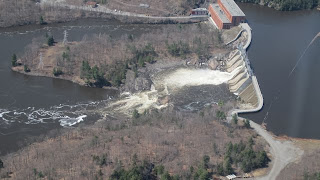There won't be any blogposts about the Ottawa and Rideau Rivers this month because I'm in another hemisphere (failing to recognize the constellations after dark).
 |
| Riverbus stop on the Parramatta River |
 |
| Sydney Harbour Bridge from Cockatoo Island |
Yesterday we took river boats in both directions from Meadowbank to downtown Sydney on the Parramatta River estuary. The boats are like commuter busses, well used and frequent. Every few hundred metres there's a "bus stop" on the bank with its name (e.g. Kissing Point) visible from the river. We passed sandy beaches, sandstone cliffs and many wharfs, the wooden posts rotting away and covered with barnacles, the concrete posts less picturesque, but sturdier. Jellyfish rise and fall in the water. You can sit on the top deck of the catamarans in the sunshine and wind--hang on to your hat!--and watch the world go by. Houses on the riverbank look very desirable and are doubtless worth millions. Most have their own private fishing docks with watercraft anchored beyond them. In the distance are the Sydney skyscrapers.
 |
| Military style camping on Cockatoo Island |
On our downriver ride we disembarked at Cockatoo Island, a former convict detention centre and shipbuilding yard which is undergoing a "Renaissance in every sense of the word" for the sake of the tourists. Indeed it was a fascinating place to explore, though the conditions for its poor inmates had been disturbingly harsh, and we were justifiably warned about the "aggressive seagulls" (with scarlet beaks and feet) that were nesting on the cliff face. Under the cliff was a field where tourists can camp in military tents overnight, if they wish, and on the other side of the island we found an ancient steam-powered crane, made in the 1880s.
 |
| The steam crane |








